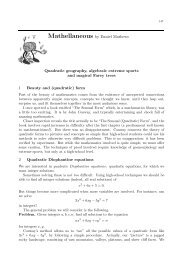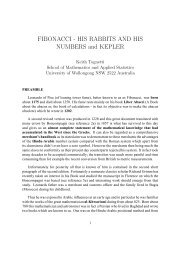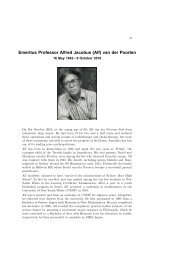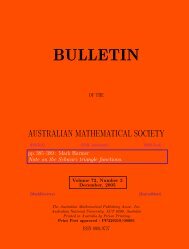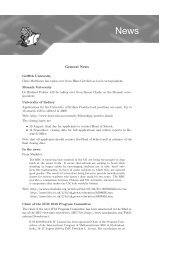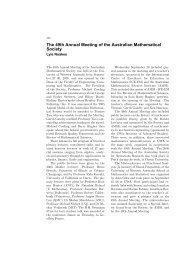Benard-Marangoni convection in a layer of fluid - Australian ...
Benard-Marangoni convection in a layer of fluid - Australian ...
Benard-Marangoni convection in a layer of fluid - Australian ...
Create successful ePaper yourself
Turn your PDF publications into a flip-book with our unique Google optimized e-Paper software.
ANZIAM J. 43(2002), 387–395<br />
ON COMPETITION BETWEEN MODES AT THE ONSET OF<br />
BÉNARD-MARANGONI CONVECTION IN A LAYER OF FLUID<br />
ISHAK HASHIM 1<br />
(Received 3 March, 1999; revised 21 October, 1999)<br />
Abstract<br />
In this paper we use classical l<strong>in</strong>ear stability theory to analyse the onset <strong>of</strong> steady and oscillatory<br />
Bénard-<strong>Marangoni</strong> <strong>convection</strong> <strong>in</strong> a horizontal <strong>layer</strong> <strong>of</strong> <strong>fluid</strong> <strong>in</strong> the more physicallyrelevant<br />
case when both the non-dimensional Rayleigh and <strong>Marangoni</strong> numbers are l<strong>in</strong>early<br />
dependent. We present examples <strong>of</strong> situations <strong>in</strong> which there is competition between modes<br />
at the onset <strong>of</strong> <strong>convection</strong> when the <strong>layer</strong> is heated from below.<br />
1. Introduction<br />
The onset and subsequent evolution <strong>of</strong> <strong>convection</strong> <strong>in</strong> a <strong>fluid</strong> is a problem <strong>of</strong> great<br />
importance to many <strong>in</strong>dustrial applications, such as crystal growth (see, for example,<br />
Hurle [6], Ostrach [10] and Schwabe [15]) and weld<strong>in</strong>g <strong>of</strong> steels (Mills and Keene [8]).<br />
Convection is also important <strong>in</strong> many other contexts, for example, <strong>in</strong> geophysics,<br />
where <strong>convection</strong> <strong>in</strong> the oceanic and cont<strong>in</strong>ental surfaces and the atmosphere can<br />
occur due to non-uniform heat<strong>in</strong>g from the sun. Indeed, the atmospheric structure <strong>of</strong><br />
planets and the Earth’s magnetic field are determ<strong>in</strong>ed largely by convective <strong>in</strong>stabilities<br />
(Zierep and Oertel [18]). We note that the problem <strong>of</strong> <strong>convection</strong> <strong>in</strong> a <strong>fluid</strong> has<br />
been <strong>of</strong> considerable <strong>in</strong>terest to applied mathematicians for over a hundred years.<br />
Convective <strong>in</strong>stabilities driven by either buoyancy (Bénard) or thermocapillary (<strong>Marangoni</strong>)<br />
effects have been the subject <strong>of</strong> a great deal <strong>of</strong> theoretical and experimental<br />
<strong>in</strong>vestigation s<strong>in</strong>ce the pioneer<strong>in</strong>g theoretical works <strong>of</strong> Rayleigh [14] and Pearson [11]<br />
respectively. However, a great deal less work has been done on the more general case<br />
<strong>in</strong> which both mechanisms act simultaneously, a situation usually termed Bénard-<br />
<strong>Marangoni</strong> <strong>convection</strong> (and hereafter abbreviated to B-M <strong>convection</strong>), which is the<br />
subject <strong>of</strong> the present work.<br />
1Pusat Pengajian Sa<strong>in</strong>s Matematik, Fakulti Sa<strong>in</strong>s dan Teknologi, Universiti Kebangsaan Malaysia,<br />
43600 Bangi Selangor, Malaysia.<br />
c○ <strong>Australian</strong> Mathematical Society 2002, Serial-fee code 1446-8735/02<br />
387
388 Ishak Hashim [2]<br />
The first study <strong>of</strong> B-M <strong>convection</strong> <strong>in</strong> a planar horizontal <strong>fluid</strong> <strong>layer</strong> with a nondeformable<br />
free surface was performed by Nield [9], who showed that for steady<br />
<strong>convection</strong> the two destabilis<strong>in</strong>g mechanisms re<strong>in</strong>force one another. Subsequently<br />
Takashima [16] showed numerically that oscillatory <strong>convection</strong> cannot occur if the free<br />
surface is non-deformable. Davis and Homsy [2] extended Nield’s work [9] on steady<br />
<strong>convection</strong> to <strong>in</strong>clude a deformable free surface and found that weak surface deformation<br />
stabilises Bénard-dom<strong>in</strong>ated <strong>convection</strong> and destabilises <strong>Marangoni</strong>-dom<strong>in</strong>ated<br />
<strong>convection</strong>.<br />
In all the early work described above the effects <strong>of</strong> buoyancy and thermocapillary,<br />
represented by the non-dimensional Rayleigh number R and <strong>Marangoni</strong> number M<br />
respectively, were taken to be <strong>in</strong>dependent. However, <strong>in</strong> a typical physical experiment<br />
the control parameter is the temperature difference across the <strong>layer</strong> (which appears<br />
l<strong>in</strong>early <strong>in</strong> both R and M), and so recent work has focused on the more physicallyrelevant<br />
case <strong>in</strong> which R and M are l<strong>in</strong>early dependent. Benguria and Depassier [1]<br />
numerically <strong>in</strong>vestigated the onset <strong>of</strong> B-M <strong>convection</strong> <strong>in</strong> a planar <strong>layer</strong> heated from<br />
below. They identified the existence <strong>of</strong> an oscillatory branch to the marg<strong>in</strong>al stability<br />
curve for the onset <strong>of</strong> <strong>convection</strong> when the free surface is sufficiently deformable<br />
and the <strong>Marangoni</strong> effects are sufficiently strong, although <strong>in</strong> all the examples they<br />
described the onset <strong>of</strong> <strong>convection</strong> was steady. Recently Hashim and Wilson [5]<br />
extended the work <strong>of</strong> Benguria and Depassier [1], and <strong>in</strong> particular gave examples <strong>of</strong><br />
situations <strong>in</strong> which the onset <strong>of</strong> <strong>convection</strong> was oscillatory. Pérez-García and Carneiro<br />
[12] also considered the same problem numerically and found examples <strong>of</strong> situations<br />
<strong>in</strong> which there is competition between a steady and an oscillatory mode and between<br />
two oscillatory modes at the onset <strong>of</strong> <strong>convection</strong> when the <strong>layer</strong> is heated from above.<br />
An excit<strong>in</strong>g recent development is the growth <strong>of</strong> <strong>in</strong>terest <strong>in</strong> understand<strong>in</strong>g how<br />
the nonl<strong>in</strong>ear competition between different modes can lead to pattern formation<br />
near or at the onset <strong>of</strong> <strong>convection</strong>. For example, Johnson and Narayanan [7] studied<br />
experimentally surface-tension-gradient-driven <strong>convection</strong> <strong>in</strong> a <strong>layer</strong> <strong>of</strong> silicone oil<br />
with an upper air gap, which was placed between two plates, near a “codimensiontwo”<br />
po<strong>in</strong>t at which two steady modes coexist. Johnson and Narayanan [7] observed<br />
a dynamic switch<strong>in</strong>g between two different flow patterns near this po<strong>in</strong>t. VanHook et<br />
al. [17] <strong>in</strong>vestigated experimentally the formation <strong>of</strong> surface-tension-gradient-driven<br />
<strong>convection</strong> patterns <strong>in</strong> a th<strong>in</strong> <strong>layer</strong> <strong>of</strong> silicone oil bounded below by a heated rigid plane<br />
boundary and above by an air <strong>layer</strong>. Specifically VanHook et al.[17] observed that both<br />
the long- and short-wavelength (hexagonal) modes can coexist for a range <strong>of</strong> liquid<br />
depths. VanHook et al.[17] observed that the presence <strong>of</strong> the hexagons suppresses the<br />
long-wavelength mode, while the presence <strong>of</strong> the long-wavelength mode may <strong>in</strong>duce<br />
the formation <strong>of</strong> hexagons. Motivated <strong>in</strong> part by these results, Golov<strong>in</strong> et al. [3]<br />
recently studied theoretically the nonl<strong>in</strong>ear evolution and secondary <strong>in</strong>stabilities <strong>of</strong><br />
<strong>Marangoni</strong> <strong>convection</strong> <strong>in</strong> a two-<strong>layer</strong> liquid-gas system with a deformable liquid-gas
[3] Bénard-<strong>Marangoni</strong> <strong>convection</strong> <strong>in</strong> a <strong>layer</strong> <strong>of</strong> <strong>fluid</strong> 389<br />
<strong>in</strong>terface, bounded from below and from above by rigid plates. Golov<strong>in</strong> et al. [3]<br />
derived a system <strong>of</strong> amplitude equations describ<strong>in</strong>g the evolution <strong>of</strong> a short-wave<br />
mode and its <strong>in</strong>teraction with the long-wave mode. The equations they obta<strong>in</strong>ed<br />
are valid when both <strong>in</strong>stability modes coexist. This work shows that the nonl<strong>in</strong>ear<br />
<strong>in</strong>teraction between these two types <strong>of</strong> <strong>Marangoni</strong> <strong>convection</strong> can yield new secondary<br />
<strong>in</strong>stabilities <strong>of</strong> the basic hexagonal <strong>convection</strong> pattern and result <strong>in</strong> complex nonstationary<br />
behaviour.<br />
In this paper we use classical l<strong>in</strong>ear stability theory to <strong>in</strong>vestigate the competition<br />
between modes at the onset <strong>of</strong> B-M <strong>convection</strong> <strong>in</strong> a horizontal planar <strong>layer</strong> <strong>of</strong> <strong>fluid</strong><br />
heated from below <strong>in</strong> the most physically-relevant case when R and M are l<strong>in</strong>early<br />
dependent. In particular, we f<strong>in</strong>d for the first time a situation <strong>in</strong> which there exists<br />
a competition between two steady modes and one oscillatory mode at the onset <strong>of</strong><br />
<strong>convection</strong>. These results extend some <strong>of</strong> the numerical results <strong>of</strong> Pérez-García and<br />
Carneiro [12]. The structure <strong>of</strong> the paper is as follows. In Sections 2 and 3 we briefly<br />
formulate and solve the appropriate l<strong>in</strong>ear stability problem. In Section 4 we present<br />
the results <strong>of</strong> numerical calculations which show examples <strong>of</strong> situations <strong>in</strong> which<br />
there are competitions between different modes at the onset <strong>of</strong> <strong>convection</strong>. F<strong>in</strong>ally, <strong>in</strong><br />
Section 5 we summarise the work.<br />
2. Problem formulation<br />
We wish to exam<strong>in</strong>e the stability <strong>of</strong> a horizontal <strong>layer</strong> <strong>of</strong> quiescent <strong>fluid</strong> <strong>of</strong> <strong>in</strong>f<strong>in</strong>ite<br />
extent and thickness d which is bounded below by a rigid solid planar boundary<br />
ma<strong>in</strong>ta<strong>in</strong>ed at a constant temperature T 1 and above by a free surface <strong>in</strong>itially at<br />
temperature T 2 and subject to a uniform vertical temperature gradient. The <strong>fluid</strong> is<br />
Newtonian and <strong>in</strong>compressible with density ² = ² 0[1−Þ.T −T 2/], where the constant<br />
² 0 is the value ² at T = T 2 and Þ>0 is the coefficient <strong>of</strong> thermal volume expansion.<br />
The free surface is <strong>in</strong> contact with a passive gas which is at constant pressure and<br />
constant temperature T ∞ and has surface tension given by the simple l<strong>in</strong>ear law<br />
− = − 0− .T −T 2/, where the constant − 0 is the value <strong>of</strong> − at T = T 2 and the constant<br />
is positive for most common <strong>fluid</strong>s. At the free surface the temperature obeys Newton’s<br />
law <strong>of</strong> cool<strong>in</strong>g and so T 1, T 2 and T ∞ are related by 1T = T 1 − T 2 = .T 2 − T ∞/hd=k<br />
where h is the heat transfer coefficient between the free surface and the passive gas<br />
above and k is the thermal conductivity <strong>of</strong> the <strong>fluid</strong>. We choose Cartesian axes with<br />
the x- andy-axes <strong>in</strong> the plane <strong>of</strong> the rigid lower boundary and the z-axis vertically<br />
upwards and non-dimensionalise the govern<strong>in</strong>g equations and boundary conditions<br />
us<strong>in</strong>g d, =d, d 2 = and .T 1 − T 2/=d as appropriate scales for distance, velocity,<br />
time and temperature gradient respectively. Us<strong>in</strong>g the Bouss<strong>in</strong>esq approximation the<br />
l<strong>in</strong>earised Navier-Stokes and heat equations and boundary conditions govern<strong>in</strong>g the
390 Ishak Hashim [4]<br />
onset <strong>of</strong> B-M <strong>convection</strong> are given by (see Hashim [4])<br />
subject to<br />
.D 2 − a 2 /<br />
�<br />
D 2 − a 2 − s<br />
P r<br />
�<br />
w − a 2 RT = 0; (1)<br />
.D 2 − a 2 − s/T + w = 0; (2)<br />
sf − w = 0;<br />
�<br />
D<br />
(3)<br />
2 − 3a 2 − s<br />
�<br />
Dw − a<br />
Pr 2<br />
�<br />
Pr G + a2<br />
�<br />
f = 0;<br />
Cr (4)<br />
.D 2 + a 2 /w + a 2 M.T − f / = 0; (5)<br />
DT + Bi.T − f / = 0; (6)<br />
evaluated on the undisturbed position <strong>of</strong> the upper free surface z = 1, and<br />
w = 0; (7)<br />
Dw = 0; (8)<br />
T = 0; (9)<br />
evaluated on the lower rigid boundary z = 0, where the operator D = d=dz denotes<br />
differentiation with respect to the vertical coord<strong>in</strong>ate z. The variables w = w.z/,<br />
T = T .z/ and f denote the vertical variation <strong>of</strong> the z-velocity and temperature and<br />
the magnitude <strong>of</strong> the free surface deflection <strong>of</strong> the l<strong>in</strong>ear perturbation to the basic<br />
state with total wave number a <strong>in</strong> the horizontal x-y plane and complex growth rate s.<br />
The non-dimensional groups appear<strong>in</strong>g <strong>in</strong> the problem are the Rayleigh number,<br />
R = gÞ1Td3 =¹ , the <strong>Marangoni</strong> number, M = 1Td=² 0 ¹, the capillary number,<br />
Cr = ² 0¹ =−0d, the Galileo number, G = gd3 =¹ 2 , the Prandtl number, Pr = ¹= ,<br />
and the Biot number, Bi = hd=k, where, <strong>in</strong> addition to the parameters def<strong>in</strong>ed above,<br />
g denotes acceleration due to gravity, ¹ the k<strong>in</strong>ematic viscosity and the thermal<br />
diffusivity <strong>of</strong> the <strong>fluid</strong>. Note that T and f can be calculated directly from (1) and<br />
boundary condition (4) respectively. Elim<strong>in</strong>at<strong>in</strong>g T between (1) and (2) yields a s<strong>in</strong>gle<br />
l<strong>in</strong>ear sixth-order ord<strong>in</strong>ary differential equation for w,<br />
�<br />
.D 2 − a 2 /.D 2 − a 2 − s/<br />
�<br />
D 2 − a 2 − s<br />
P r<br />
�<br />
+ a 2 �<br />
R w = 0: (10)<br />
The Rayleigh number R and the <strong>Marangoni</strong> number M are related by M = 0 R where<br />
0 = =² 0gÞd 2 . We shall <strong>in</strong>vestigate the most physically-relevant case <strong>in</strong> which 0 is<br />
held constant and so R and M are l<strong>in</strong>early dependent. Note that <strong>in</strong> the limit C r → 0<br />
the free surface is weakly deformable, while <strong>in</strong> the limit C r →∞it is strongly<br />
deformable. In the special case C r =∞, P r = 1andB i = 0 we recover the problem
[5] Bénard-<strong>Marangoni</strong> <strong>convection</strong> <strong>in</strong> a <strong>layer</strong> <strong>of</strong> <strong>fluid</strong> 391<br />
treated numerically by Benguria and Depassier [1], while if we write G = B o=P rC r ,<br />
where B o = ² 0gd 2 =− 0 is the Bond number, then we recover the problem treated<br />
numerically by Pérez-García and Carneiro [12] <strong>in</strong> the special case B o = 0:1, P r = 1<br />
and B i = 0.<br />
3. Solution <strong>of</strong> the l<strong>in</strong>earised problem<br />
Equations (1) and (2) together with the boundary conditions (3)–(9) constitute a<br />
l<strong>in</strong>ear eigenvalue problem for the unknown temporal exponent s. The general solution<br />
<strong>of</strong> (10)is<br />
w.z/ =<br />
6�<br />
Aie ¾i z ; (11)<br />
where ¾ 1;::: ;¾ 6 are the six dist<strong>in</strong>ct roots <strong>of</strong> the sixth-order algebraic equation<br />
.¾ 2 − a 2 /.¾ 2 − a 2 − s/<br />
i=1<br />
�<br />
¾ 2 − a 2 − s<br />
P r<br />
�<br />
+ a 2 R = 0; (12)<br />
and A i (i = 1;::: ;6) are arbitrary constants. Impos<strong>in</strong>g boundary conditions (3), (5)<br />
and (6)–(9), where expressions for T and f are obta<strong>in</strong>ed from (1) and (4) respectively,<br />
yields a l<strong>in</strong>ear system <strong>of</strong> the form MA = 0, where A =[A 1;::: ;A 6] T . In general,<br />
the 6 × 6 coefficient matrix M (whose entries depend on a, R, s, C r, G, 0, P r and B i)<br />
is complex and may be rather complicated, and so, <strong>in</strong> general, it has to be calculated<br />
either numerically or symbolically us<strong>in</strong>g a symbolic algebra package. In this paper<br />
we use a FORTRAN 77 program employ<strong>in</strong>g the Numerical Algorithms Group (NAG)<br />
rout<strong>in</strong>e F03ADF and runn<strong>in</strong>g on a SUN SPARCstation 1+ to evaluate the determ<strong>in</strong>ant<br />
<strong>of</strong> M us<strong>in</strong>g LU factorisation with partial pivot<strong>in</strong>g. A modification <strong>of</strong> the Powell [13]<br />
hybrid algorithm, which is a comb<strong>in</strong>ation <strong>of</strong> Newton’s method and the method <strong>of</strong><br />
steepest descent, implemented us<strong>in</strong>g NAG rout<strong>in</strong>e C05NBF is then used to f<strong>in</strong>d the<br />
eigenvalues <strong>of</strong> M by solv<strong>in</strong>g the two non-l<strong>in</strong>ear equations obta<strong>in</strong>ed from the real and<br />
imag<strong>in</strong>ary parts <strong>of</strong> the determ<strong>in</strong>ant <strong>of</strong> M.<br />
The marg<strong>in</strong>al stability curves <strong>in</strong> the .a; R/ plane on which Re.s/ = 0 separate<br />
regions <strong>of</strong> unstable modes with Re.s/ >0 from those <strong>of</strong> stable modes with Re.s/ 0.
392 Ishak Hashim [6]<br />
R<br />
1200<br />
1100<br />
1000<br />
900<br />
800<br />
700<br />
600<br />
500<br />
0<br />
1<br />
2<br />
3<br />
a<br />
0 = 0:06<br />
0 = 0:0685<br />
0 = 0:1<br />
FIGURE 1. Numerically-calculated oscillatory marg<strong>in</strong>al stability curves show<strong>in</strong>g a competition between<br />
two oscillatory modes for 0 = 0:0685 <strong>in</strong> the case Cr =∞, G = 250, Pr = 1 and Bi = 0.<br />
Figures 1 and 2 illustrate two <strong>in</strong>terest<strong>in</strong>g possibilities for competition between<br />
different modes at the onset <strong>of</strong> <strong>convection</strong>. Figure 1 shows part <strong>of</strong> the marg<strong>in</strong>al curves<br />
for the case C r =∞, G = 250, P r = 1andB i = 0 when oscillatory <strong>convection</strong><br />
is the preferred mode <strong>of</strong> <strong>in</strong>stability and the oscillatory marg<strong>in</strong>al curves have two<br />
local m<strong>in</strong>ima. The two m<strong>in</strong>ima are approximately equal when 0 = 0:0685. Similar<br />
competition between two oscillatory modes was previously found by Pérez-García<br />
and Carneiro [12] when 0
[7] Bénard-<strong>Marangoni</strong> <strong>convection</strong> <strong>in</strong> a <strong>layer</strong> <strong>of</strong> <strong>fluid</strong> 393<br />
R<br />
3000<br />
2500<br />
2000<br />
1500<br />
1000<br />
500<br />
0<br />
0<br />
1<br />
2<br />
FIGURE 2. Numerically-calculated marg<strong>in</strong>al stability curves (steady—solid l<strong>in</strong>e, oscillatory—dashed<br />
l<strong>in</strong>e) <strong>in</strong> the case Cr = 2:73 × 10 −3 , G = 36:63, 0 = 0:0490, Pr = 1 and Bi = 0.<br />
analytical expression obta<strong>in</strong>ed by Hashim and Wilson [5] <strong>in</strong> the limit a → 0.<br />
In Figure 3 we have plotted numerically-calculated values <strong>of</strong> 0 c (at which a steady<br />
mode and an oscillatory mode compete) as a function <strong>of</strong> C r and extend the results <strong>of</strong><br />
Pérez-García and Carneiro [12] <strong>in</strong> the case P r = 1, G = 0:1=C r and B i = 0. The<br />
regions below (0 0 c) the curve represent situations <strong>in</strong> which<br />
<strong>convection</strong> first sets <strong>in</strong> as oscillatory and steady motions respectively. We found that<br />
0 c � 0 when C r � 1:58 × 10 −3 <strong>in</strong> the case P r = 1, G � 63:29 and B i = 0. In this<br />
case Pérez-García and Carneiro [12] obta<strong>in</strong>ed C r = 1:7 × 10 −3 us<strong>in</strong>g their numerical<br />
method. Figure 3 shows <strong>in</strong> particular that oscillatory motions can be the preferred<br />
mode <strong>of</strong> <strong>in</strong>stability for small enough 0 c > 0 (that is, R > 0) and large enough C r<br />
and thus extends the results <strong>of</strong> Pérez-García and Carneiro [12] who showed only that<br />
<strong>convection</strong> first sets <strong>in</strong> as oscillatory motions for 0 c < 0.<br />
a<br />
5. Conclusions<br />
In this paper we used classical l<strong>in</strong>ear stability theory to <strong>in</strong>vestigate the competition<br />
between modes at the onset <strong>of</strong> B-M <strong>convection</strong> <strong>in</strong> a horizontal planar <strong>layer</strong> <strong>of</strong> <strong>fluid</strong><br />
heated from below <strong>in</strong> the most physically-relevant case when R and M are l<strong>in</strong>early<br />
dependent. The l<strong>in</strong>ear analysis presented <strong>in</strong> this paper revealed a number <strong>of</strong> situations<br />
with competition between different k<strong>in</strong>ds <strong>of</strong> modes which could be studied <strong>in</strong> a similar<br />
3<br />
4<br />
5
394 Ishak Hashim [8]<br />
0 c<br />
0.1<br />
0.05<br />
0<br />
-0.05<br />
-0.1<br />
0<br />
steady<br />
0.001<br />
0.002<br />
C r<br />
oscillatory<br />
0.003<br />
0.004<br />
0.005<br />
FIGURE 3. Numerically-calculated values <strong>of</strong> 0c at which both steady and oscillatory modes compete<br />
plotted as a function <strong>of</strong> Cr <strong>in</strong> the case Pr = 1, G = 0:1=Cr and Bi = 0. Note that 0c � 0 when<br />
Cr � 1:58 × 10 −3 .<br />
manner to that used by Golov<strong>in</strong> et al. [3]. In particular, we obta<strong>in</strong>ed for the first time<br />
a situation <strong>in</strong> which two steady modes and an oscillatory mode compete at the onset<br />
<strong>of</strong> <strong>convection</strong>. It would be very <strong>in</strong>terest<strong>in</strong>g to attempt an experimental verification <strong>of</strong><br />
the novel features revealed by analysis <strong>in</strong> this paper.<br />
Acknowledgements<br />
This work was done while the author was a PhD student at the University <strong>of</strong><br />
Strathclyde, United K<strong>in</strong>gdom, under the supervision <strong>of</strong> Dr S. K. Wilson and supported<br />
by Universiti Kebangsaan Malaysia, Malaysia. The author wishes to thank the two<br />
anonymous referees for suggestions which led to an improvement to the paper.<br />
References<br />
[1] R. D. Benguria and M. C. Depassier, “On the l<strong>in</strong>ear stability theory <strong>of</strong> Bénard-<strong>Marangoni</strong> <strong>convection</strong>”,<br />
Phys. Fluids A 1 (7) (1989) 1123–1127.<br />
[2] S. H. Davis and G. M. Homsy, “Energy stability theory for free surface problems: Buoyancythermocapillary<br />
<strong>layer</strong>s”, J. Fluid Mech. 98 (3) (1980) 527–553.
[9] Bénard-<strong>Marangoni</strong> <strong>convection</strong> <strong>in</strong> a <strong>layer</strong> <strong>of</strong> <strong>fluid</strong> 395<br />
[3] A. A. Golov<strong>in</strong>, A. A. Nepomnyashchy and L. M. Pismen, “Nonl<strong>in</strong>ear evolution and secondary<br />
<strong>in</strong>stabilities <strong>of</strong> <strong>Marangoni</strong> <strong>convection</strong> <strong>in</strong> a liquid-gas system with deformable <strong>in</strong>terface”, J. Fluid<br />
Mech. 341 (1997) 317–341.<br />
[4] I. Hashim, “Theoretical analysis <strong>of</strong> the onset <strong>of</strong> Bénard-<strong>Marangoni</strong> <strong>convection</strong>”, Ph. D. Thesis,<br />
University <strong>of</strong> Strathclyde, UK, 1998.<br />
[5] I. Hashim and S. K. Wilson, “The onset <strong>of</strong> Bénard-<strong>Marangoni</strong> <strong>convection</strong> <strong>in</strong> a horizontal <strong>layer</strong> <strong>of</strong><br />
<strong>fluid</strong>”, Int. J. Engng Sci. 37 (5) (1999) 643–662.<br />
[6] D. T. J. Hurle, “Surface aspects <strong>of</strong> crystal growth from the melt”, Adv. <strong>in</strong> Colloid Interface Sci. 15<br />
(1981) 101–130.<br />
[7] D. Johnson and R. Narayanan, “Experimental observation <strong>of</strong> dynamic mode switch<strong>in</strong>g <strong>in</strong><br />
<strong>in</strong>terfacial-tension-driven <strong>convection</strong> near a codimension-two po<strong>in</strong>t”, Phys. Rev. E 54 (4) (1996)<br />
3102–3104.<br />
[8] K. C. Mills and B. J. Keene, “Factors affect<strong>in</strong>g variable weld penetration”, Int. Materials Rev. 35<br />
(4) (1990) 185–216.<br />
[9] D. A. Nield, “Surface tension and buoyancy effects <strong>in</strong> cellular <strong>convection</strong>”, J. Fluid Mech. 19<br />
(1964) 341–352.<br />
[10] S. Ostrach, “Fluid mechanics <strong>in</strong> crystal growth—The 1982 Freeman Scholar Lecture”, J. Fluids<br />
Engng 105 (1983) 5–20.<br />
[11] J. R. A. Pearson, “On <strong>convection</strong> cells <strong>in</strong>duced by surface tension”, J. Fluid Mech. 4 (1958)<br />
489–500.<br />
[12] C. Pérez-García and G. Carneiro, “L<strong>in</strong>ear stability analysis <strong>of</strong> Bénard-<strong>Marangoni</strong> <strong>convection</strong> <strong>in</strong><br />
<strong>fluid</strong>s with a deformable free surface”, Phys. Fluids A 3 (2) (1991) 292–298.<br />
[13] M. J. D. Powell, “A hybrid method for nonl<strong>in</strong>ear equations”, <strong>in</strong> Numerical methods for nonl<strong>in</strong>ear<br />
algebraic equations (ed. P. Rab<strong>in</strong>owitz), (Gordon and Breach, London, 1970) 87–114.<br />
[14] Lord Rayleigh, “On <strong>convection</strong> currents <strong>in</strong> a horizontal <strong>layer</strong> <strong>of</strong> <strong>fluid</strong>, when the higher temperature<br />
is on the under side”, Phil. Mag. 32 (6) (1916) 529–546.<br />
[15] D. Schwabe, “Surface-tension-driven flow <strong>in</strong> crystal growth melts”, Crystals 11 (1988) 75–112.<br />
[16] M. Takashima, “Nature <strong>of</strong> the neutral state <strong>in</strong> convective <strong>in</strong>stability <strong>in</strong>duced by surface tension and<br />
buoyancy”, J. Phys. Soc. Japan 28 (4) (1970) 810.<br />
[17] S. J. VanHook, M. F. Schatz, W. D. McCormick, J. B. Swift and H. L. Sw<strong>in</strong>ney, “Long-wavelength<br />
<strong>in</strong>stability <strong>in</strong> surface-tension-driven Bénard <strong>convection</strong>”, Phys. Rev. Lett. 75 (24) (1995) 4397–<br />
4400.<br />
[18] J. Zierep and H. Oertel Jr., Convective transport and <strong>in</strong>stability phenomena (G. Braun, Karlsruhe,<br />
1982).





